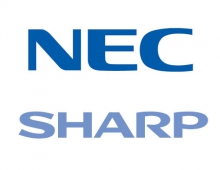
Sharp's Efficient Fuel Cell Technology Could Replace Lithium-ion Batteries
Sharp said Thursday it has developed a technology to produce small fuel cells that have almost the same volume as lithium-ion batteries but a longer continuous lifespan.
The Japanese company claims that it has achieved the world's highest power density, 0.3W/cc, for direct methanol fuel cells (DMFC) for mobile equipment. This new technology enables efficient power generation from a small cell volume. Thus, the use of this technology can make it possible to develop fuel cells that have almost the same volume but a longer continuous-use lifespan than lithium-ion batteries, which are the main type currently in use.
Sharp plans to promote further research and development for the practical application of fuel cells for mobile equipment such as PDAs, electronic dictionaries, and notebook computers.
Fuel cells use energy produced by the chemical reaction between hydrogen and oxygen, meaning that they have a small impact on the global environment. Also, fuel cells are expected to become the next-generation power generating devices because of their high generating efficiency that comes from converting chemical energy directly into electrical energy.
Generally, DMFC have a simple structure in which power is generated through a chemical reaction between methanol supplied directly to the power generation part and oxygen in the air, making them suitable for miniaturization.
However, the relatively low power density of the current DMFCs increases the size of the power generation part and, as a result, increases the total cell volume.
Sharp has developed the three-dimensional highly integrated stack structure through the use of thin cells made using microfabrication techniques. This structure can be created by the alternate lamination of reed-shaped thin cells arranged in parallel at fixed intervals and reed-shaped (porous) spacers, with the cells and spacers running perpendicular to each other like a grid. With this structure, uniform and continuous spaces are secured, making it possible to increase the cell surface area per unit volume and smoothly circulate the air that is one of the sources for power generation.
Sharp said that it has managed to improve power density per unit volume and achieved the world's highest level, 0.3W/cc (about 7 times greater than previous Sharp technology).
The Japanese company believes that in the future, cell volume can be further miniaturized, making them competitive to the currently mainstream lithium-ion batteries, while they will offer a longer lifespan.
Sharp plans to promote further research and development for the practical application of fuel cells for mobile equipment such as PDAs, electronic dictionaries, and notebook computers.
Fuel cells use energy produced by the chemical reaction between hydrogen and oxygen, meaning that they have a small impact on the global environment. Also, fuel cells are expected to become the next-generation power generating devices because of their high generating efficiency that comes from converting chemical energy directly into electrical energy.
Generally, DMFC have a simple structure in which power is generated through a chemical reaction between methanol supplied directly to the power generation part and oxygen in the air, making them suitable for miniaturization.
However, the relatively low power density of the current DMFCs increases the size of the power generation part and, as a result, increases the total cell volume.
Sharp has developed the three-dimensional highly integrated stack structure through the use of thin cells made using microfabrication techniques. This structure can be created by the alternate lamination of reed-shaped thin cells arranged in parallel at fixed intervals and reed-shaped (porous) spacers, with the cells and spacers running perpendicular to each other like a grid. With this structure, uniform and continuous spaces are secured, making it possible to increase the cell surface area per unit volume and smoothly circulate the air that is one of the sources for power generation.
Sharp said that it has managed to improve power density per unit volume and achieved the world's highest level, 0.3W/cc (about 7 times greater than previous Sharp technology).
The Japanese company believes that in the future, cell volume can be further miniaturized, making them competitive to the currently mainstream lithium-ion batteries, while they will offer a longer lifespan.





















